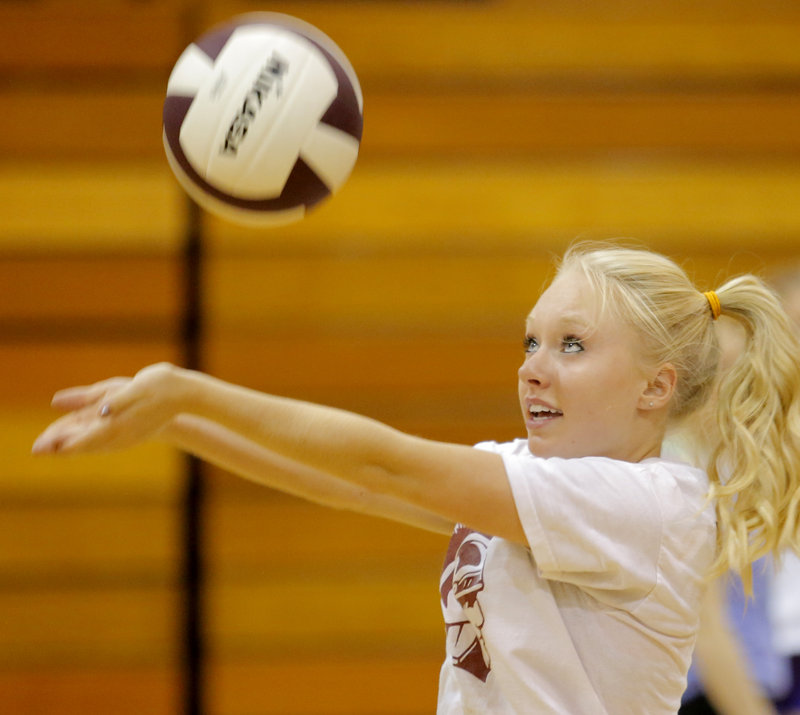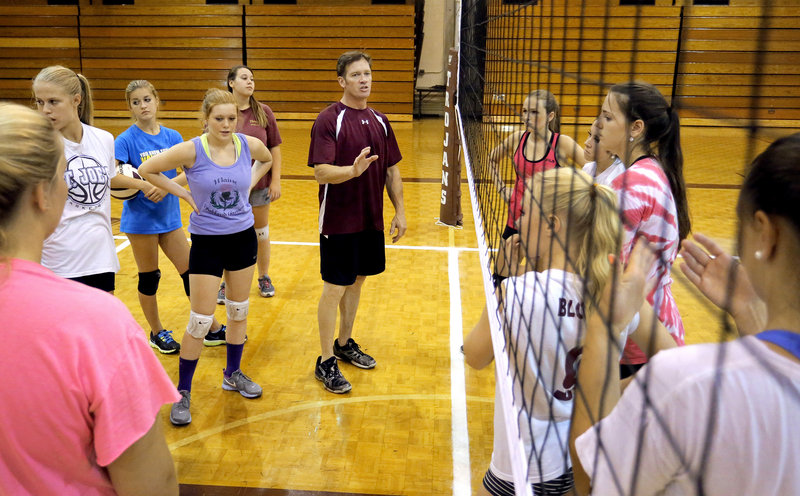If Maine high school volleyball was a Wall Street stock, its performance would be marked by slow but steady growth.
But if the participation numbers at Thornton Academy are a viable predictor, the market for volleyball is ready to spike.
Started with grass-roots interest from a dozen or so girls four years ago who wanted to play volleyball after school, Thornton Academy has quickly transitioned from loosely organized activity to club team to junior varsity to having its first-ever varsity team this fall.
“What we have right now are sheer numbers,” Thornton Coach Keith O’Leary said.
O’Leary is keeping nearly 75 players in the program with the equivalent of two junior varsity and two freshmen teams.
South Portland High is also putting its first varsity team on the court this season, bringing the number of teams in the state to 25. Fifteen, including Thornton and South Portland, are in Class A. Ten schools with enrollment fewer than 500 students compete in Class B.
Several area coaches indicated they are surprised more schools haven’t added volleyball since the MPA first sanctioned the sport in 1997.
South Portland Coach Autumn Hawkes appreciates the growth that has occurred.
Hawkes, 28, played on the first-ever varsity team at Greely when she was a senior in high school.
“When I started as a junior in high school we were playing the Down East teams. We were playing every weekend, tri-matches Down East,” Hawkes said. “To see the growth I’ve seen in the last 10 years is huge. We definitely still have a long ways to go but it’s definitely bigger than it was.”
South Portland has 30 players with “new ones showing up every day,” Hawkes said.
O’Leary said his experience with the Thornton Academy team indicates there are three significant steps to going varsity.
First, there needs to be interest among the female students to have a team. Second is assuring administrators and other coaches that the volleyball roster won’t be made up of athletes poached from other fall sports. Third is making sure the facility is up to snuff.
“We have a pretty old facility so it was never set up for volleyball,” O’Leary said. “We didn’t have stanchions so we had to dig out the holes and get the equipment but (TA Athletic Director) Gary (Stevens) was definitely supportive and once the board of trustees saw the interest and lack of impact it had on other sports it was full speed ahead.”
FOR THE FIRST six years of MPA-sanctioned play, the single-class tournament was dominated by two small Down East schools — Jonesport-Beals and Woodland. Greely became the first southern Maine team to win a state title in 2003 and has won eight of the past 10 Class A championships, including last season.
“One reason I got into volleyball coaching was to raise the level of volleyball in Maine and I think we’ve done that,” Greely Coach Kelvin Hasch said. “From what I see, this year the league is pretty even in spots.”
Class B was formed in 2010 and is primarily a Down East league with the addition of Yarmouth High and North Yarmouth Academy.
“Class B has to grow,” Yarmouth Coach Jim Senecal said. “The way it’s going to grow may not be in (adding) more schools of (smaller) size, but by the way we perceive Class B. It may be to grow we need to have more balance in leagues.”
Senecal said he’s heard Gardiner has a club team and there is interest at Class A schools Brunswick and Mt. Ararat. And yet several coaches said they are surprised the sport hasn’t grown faster.
“I don’t understand it. It’s a cheap sport. You’re using a gym that’s basically vacant in the fall season,” Scarborough Coach Jon Roberts said.
When Kennebunk started its program in 2006 it became the sixth southern Maine team with volleyball, said Rams Coach Craig Richardson, joining Greely, Scarborough, Gorham, Biddeford, and Yarmouth.
Over the next six years another half-dozen southern schools created varsity teams: Falmouth, Cape Elizabeth, North Yarmouth Academy, and most recently Windham, Lake Region and Cheverus.
Hasch said he suspects the tight economy makes athletic directors hesitant to propose adding any sport. He estimates the annual cost to run a program is roughly $10,000 to cover a coaching stipend, busing and officials.
“They all look at our program and we probably spend the most,” Hasch said, noting that his booster group raises $12,000 a year to defray costs for out-of-state scrimmages and assistant coaches. “But we started poor when we started the program.”
Other factors that could curb growth are a small pool of certified and available referees for high school matches and few middle school programs.
Scarborough’s Roberts believes volleyball — and other sports like swimming and gymnastics — would benefit from fewer restrictions on coaches working with varsity-age athletes in the club season.
“Maine is very restrictive compared to other states with regard to how much interaction players can have with their coaches outside of the season,” Roberts said.
“I work with a U14 team because I love coaching and can’t work with the older girls, but more and more coaches are (choosing) between club teams and varsity teams.”
Regardless of obstacles, Thornton Academy’s O’Leary believes the sport is primed for a boost in participation.
“People are recognizing that it’s a good spectator sport at a pretty low cost for the kids,” O’Leary said.
“For the player it’s getting some sneakers and some knee pads and a ball and they’re ready to rock.”
Steve Craig can be reached at 791-6413 or at:
scraig@mainetoday.com
Twitter: SteveCCraig
Send questions/comments to the editors.




